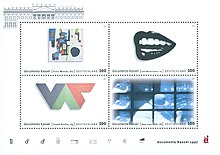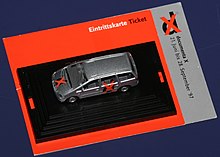documenta X
The 10th documenta , the documenta X (or: dX as a symbol with the red "X" as the Roman "10" behind or on the small black "d") took place from June 21 to September 28, 1997 under the artistic direction the French Catherine David in Kassel . The managing director of documenta and the Museum Fridericianum Veranstaltungs-GmbH was Bernd Leifeld for the first time .
Catherine David demanded that documenta X be a “retro perspective”. Behind this creation of words concealed the fact that the dX, as the last major art exhibition of the 20th century, should be a retrospective on the one hand , i.e. a review in order to “take a critical look at history, the recent post-war past and what of it culture and contemporary art. ”(Catherine David in the preface to the short guide to the dX). From a “critical” “current” perspective, this perspective was intended to examine important positions that emerged in the 1960s and were thematized in the art world in the last 30 years of the 20th century.
Catherine David linked political and social topics in the exhibition concept of the dX and for the first time raised the claim for a globalized approach for the documenta . With this approach, the first course for the internationalized documenta11 was set by Okwui Enwezor in 2002.
The lecture and event series 100 days - 100 guests was placed as the second level of the exhibition concept . Here, among others, philosophers, art critics, journalists, filmmakers, architects and urban planners, psychoanalysts, economists and other people had their say in order to provide the actual exhibition with an additional theoretical framework.
The catalog for documenta X (idea and concept by Catherine David and Jean-François Chevrier ) was no longer an exhibition catalog in the true sense of the word , but the book for documenta X , subtitle: Politics - Poetics . The over 800-page work is an extensive reader with which the attempt was made to “ define a political context for the interpretation of artistic activity at the end of the 20th century” (foreword).
628,776 visitors in Kassel were able to grapple with the question of whether the documenta X was too “ intellectual ”, as some critics accused the documenta director.
Exhibition locations
New to the exhibition concept of documenta X was the creation of a didactic course as a guided exhibition path. The exhibition and event locations of the d10 were arranged in a logical order that began at the Kulturbahnhof (the former main train station, in the symbolic sense of an arrival point ). In the Kulturbahnhof, the south wing of the building and the railway systems were included in the exhibition. The course continued through the underpasses of the Kulturbahnhof and the stairs street and along the stairs street itself. Further on the Friedrichsplatz the exhibition buildings Museum Fridericianum , Ottoneum and the documenta hall were included in the schedule. Down to the Karlsaue over the orangery , the course ended on the Fulda with Martin Kippenberger's transportable underground entrance as an antipode to the starting point and symbolic “departure point”. With the purchase of an entrance ticket, visitors to documenta 10 were given a map with directions and a site plan for the course.
Works of art
Painting was less represented at the dX than at the previous documents. The presence in the urban space via outdoor works of art was also much more reserved.
For the first time, the Internet was represented as a new medium for artistic expression. (Reportage) photography and video art took up a large space. The documenta X was accompanied by an extensive film program.
In the literature on documenta X, two works appear again and again that are obviously symbolic for the dX: Peter Kogler's "tubes" painting ("wallpaper") on the walls and ceilings of the (otherwise almost empty) documenta hall and Gerhard Richter's "Atlas" made up of hundreds of sketches, photos, studies and drafts that represented his actual oeuvre.
“There was no way I wanted to match any kind of visual consensus in choosing the artists . My intention was to stay close to the variety of “tempi” ” (Catherine David).
Participating artists
A total of 121 artists took part in the event.
- A Vito Acconci Studio , Robert Adams , Pawel Althamer , Archigram , Archizoom , Art & Language , Aya & Gal
- B Oladélé Ajiboyé Bamgboyé , Lothar Baumgarten , Catherine Beaugrand , Samuel Beckett , Joachim Blank & Karl Heinz Jeron , Ecke Bonk , Florian Borkenhagen , Marcel Broodthaers , Heath Bunting , Charles Burnett , Jean-Marc Bustamante
- F Öyvind Fahlström , Patrick Faigenbaum , Harun Farocki , Feng Mengbo , Fischli / Weiss , Peter Friedl , Holger Friese
- G Daniele del Giudice , Liam Gillick , Gob Squad , Heiner Goebbels , Dorothee Golz , Dan Graham , Toni Grand , Hervé Graumann , Johan Grimonprez , Ulrike Grossarth
- H Hans Haacke , Raymond Hains , Richard Hamilton , Siobhán Hapaska , Carl Michael von Hausswolff , Michal Heiman , Nigel Henderson , Jörg Herold , Christine Hill , Carsten Höller & Rosemarie Trockel , Christine Hohenbüchler and Irene Hohenbüchler , Edgar Honetschläger , Felix Stephan Huber , Hybrid WorkSpace
- J Jackson Pollock Bar , Wang Jianwei , Jodi ( Joan Heemskerk & Dirk Paesmans ), Jon Jost
- K On Kawara , Mike Kelley & Tony Oursler , William Kentridge , Martin Kippenberger , Joachim Koester , Peter Kogler , Aglaia Konrad , Rem Koolhaas , Hans-Werner Kroesinger
- L Suzanne Lafont , Sigalit Landau , Maria Lassnig , Jan Lauwers , Jozef Legrand , Antonia Lerch , Helen Levitt , Geert Lovink
- M Chris Marker , Kerry James Marshall , Christoph Marthaler & Anna Viebrock , Gordon Matta-Clark , Steve McQueen , Yana Milev , Mariella Mosler , Jean-Luc Moulène , Reinhard Mucha , Christian Philipp Müller , Matthias Müller , Matt Mullican , Antoni Muntadas
- P Adam Page , Gérard Paris-Clavel , Marc Pataut , Raoul Peck , Marko Peljhan , Michelangelo Pistoletto , Lari Pittman , Philip Pocock , Emilio Prini , Stefan Pucher
- S Christoph Schlingensief , Anne-Marie Schneider , Jean-Louis Schoellkopf , Thomas Schütte , Michael Simon , Abderrahmane Sissako , Alison Smithson & Peter Smithson , Alexander Sokurov , Nancy Spero , Wolfgang Staehle , Erik Steinbrecher , Meg Stuart , Hans-Jürgen Syberberg
- T Slaven Tolj , Tunga , Uri Tzaig , Rosemarie Trockel
- W Martin Walde , Jeff Wall , Marijke van Warmerdam , Lois Weinberger , Franz West , Garry Winogrand , Eva Wohlgemuth / Andreas Baumann
The 100 guests
- A Ackbar Abbas , Giorgio Agamben , Sadiq al-Azm , Ariella Azoulay
- B Étienne Balibar , Carlos Basualdo , Ulrich Beck , Fethi Benslama , Ulrich Bielefeld , Azmi Bishara , Stefano Boeri , Ginevra Bompiani , Colette Braeckman
- C Cabelo , Ery Camara , Yan Ciret
- D Clémentine Deliss , Diedrich Diederichsen , Corinne Diserens
- E Manfred Eicher , Okwui Enwezor
- F Nuruddin Farah , Michel Fehrer , Alexander García Düttmann
- G Armand Gatti , Peter Gente , Susan George , Édouard Glissant , Serge Gruzinski
- H Andreas Huyssen
- J Alain Joxe , François Jullien
- K Thomas W. Keenan
- L Philippe Lacoue-Labarthe , Simon Lamunière , Yang Lian , Laurence Louppe , Geert Lovink
- M Chris Marker , Rashid Masharawi , Paulo Mendes da Rocha , Masao Miyoshi , Tierno Monénembo , Carlos Monsiváis , Valentin-Yves Mudimbe
- N Jean-Luc Nancy
- O Michael Oppitz
- P Christos Papoulias , Raoul Peck , Marko Peljhan , Claus Philipp , Michelangelo Pistoletto , Philip Pocock
- R Suely Rolnik , Raoul Ruiz , Michail Kusmitsch Ryklin
- S Edward W. Said , Saskia Sassen , Walter Seitter , Vandana Shiva , Wolf Singer , Edward Soja , Wole Soyinka
- Z François Zourabichvili
Works of art remaining in Kassel
- That about plants / is one with them by Lois Weinberger
Planting of a railroad track with neophytes and native vegetation, length 100 m; Location: Kulturbahnhof (main station), platform 1
literature
- (documenta 10 catalog): Politics - Poetics - the book on documenta X; Kassel / Ostfildern 1997, ISBN 3-89322-909-4 , (German) / ISBN 3-89322-911-6 , (English)
- Stehr, Werner / Kirschenmann, Johannes (eds.): Materials for documenta X; Ostfildern 1997, ISBN 3-89322-921-3 .
- documenta X short guide; Ostfildern 1997, ISBN 3-89322-938-8 .
- dX 100 days - 100 guests / 100 days - 100 guests; Lectures, discussions and events / films / theater: program; Kassel 1997
- dX Parcours - exhibition; Leader; Kassel 1997
- Kimpel, Harald: documenta, myth and reality , Cologne 1997, ISBN 3-7701-4182-2 .
- Schwarze, Dirk: Milestones: 50 years of documenta , Kassel 2005, ISBN 3-936962-23-5 .
- Glasmeier, Michael / Stengel, Karin (Ed.): 50 Jahre / Years documenta 1955 - 2005; 2 volumes: Discrete Energies / archive in motion; Kassel 2005, ISBN 3-86521-146-1 .



